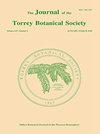阿肯色州南部一棵松木硬木的组成、结构和动态
IF 0.8
4区 生物学
Q4 PLANT SCIENCES
引用次数: 25
摘要
林分基部面积以火炬松(Pinus taeda L.)、短叶松(Pinus echinata Mill.)和白栎(Quercus alba L.)为主。硬木数量最多,以耐阴树种为主,如红枫(Acer rubrum L.)、开花茱萸(Cornus florida L.)、黑胶(Nyssa sylvatica L.)和有翅榆树(Ulmus alata micx .),特别是在林下和林下。大片的松树、橡树和桉树散布在整个林分中,一些个体的胸径超过100厘米,高45米。林冠层树木很少被证明是健康的,但一些树桩、原木和增量岩心表明,主要的林冠松树年龄在100至150岁之间,最大的个体超过200岁。松树贡献了最多的粗木屑。枯木的平均体积明显少于美国东部的其他原始高地森林,这主要是由于打捞。在没有火灾或伐木等大规模扰动的情况下,不耐阴的松树、橡树和桉树(Liquidambar styraciflua L.)的数量将显著下降,取而代之的是更耐阴的树种。本文章由计算机程序翻译,如有差异,请以英文原文为准。
Composition, structure, and dynamics of a pine-hardwood old-growth remnant in southern Arkansas
different overstory tree species, with loblolly pine (Pinus taeda L.), shortleaf pine (Pinus echinata Mill.), and white oak (Quercus alba L.) comprising the majority of stand basal area. Hardwoods are most numerous, dominated by shade-tolerant species such as red maple (Acer rubrum L.), flowering dogwood (Cornus florida L.), blackgum (Nyssa sylvatica L.), and winged elm (Ulmus alata Michx.), especially in the subcanopy and understory. Large pines, oaks, and sweetgum are scattered throughout the stand, with some individuals exceeding 100 cm DBH and 45 m tall. Overstory trees rarely proved sound enough to age, but some stumps, logs, and increment cores suggest that the dominant canopy pines are 100 to 150 years old, with the largest individuals exceeding 200 years. Pines contributed the greatest amount of coarse woody debris. The average volume of dead wood was noticeably less than other examples of old-growth upland forest in the eastern United States, attributable largely to salvage. Increased windthrow and the salvage of dead and dying pines have become the primary perturbations of the LWDE Without large-scale disturbance like catastrophic fire or logging, shadeintolerant pines, oaks, and sweetgum (Liquidambar styraciflua L.) will decline in prominence, to be replaced by more shade-tolerant species.
求助全文
通过发布文献求助,成功后即可免费获取论文全文。
去求助
来源期刊
CiteScore
0.70
自引率
0.00%
发文量
16
审稿时长
>12 weeks
期刊介绍:
The Journal of the Torrey Botanical Society (until 1997 the Bulletin of the Torrey Botanical Club), the oldest botanical journal in the Americas, has as its primary goal the dissemination of scientific knowledge about plants (including thallopyhtes and fungi). It publishes basic research in all areas of plant biology, except horticulture, with an emphasis on research done in, and about plants of, the Western Hemisphere.

 求助内容:
求助内容: 应助结果提醒方式:
应助结果提醒方式:


